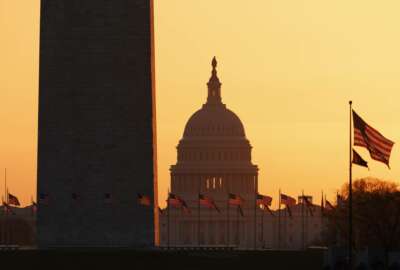
Updated: What the $2T coronavirus stimulus means for federal employees, retirees and contractors
The president has signed the $2 trillion stimulus and emergency supplemental appropriations package into law. It will have implications for federal employees and...
This story was updated on Friday, March 27, 2020 at 5:15 p.m. to reflect the president’s signing of the stimulus and emergency appropriations package.
The president on Friday afternoon signed a $2 trillion stimulus and emergency appropriations package into law, part of a sweeping effort by the federal government to respond to the economic and health impacts of the coronavirus pandemic.
The Senate passed the bill early Thursday morning with a 96-0 vote. The House passed the measure Friday afternoon with a voice vote.
The massive bill has two parts.
Part A covers an expansion of unemployment benefits and federal business loans and authorizes $1,200 “recovery” checks to most Americans under a certain salary threshold.
Part B covers some $340 billion in coronavirus emergency supplemental appropriations, including some resources for agencies to implement “part A” of the massive stimulus package.
The Labor Department, for example, will receive an additional $15 million to implement new paid sick leave programs and expanded unemployment benefits.
The IRS will get at least $250 million more to respond to the costs of extending the tax filing season and to implement pieces of the stimulus bill itself. The agency’s employees will be responsible for processing recovery checks for the American public.
The IRS has the freedom to move these funds around among its taxpayer services, enforcement or operations support accounts.
The Department of Housing and Urban Development, Securities and Exchange Commission and Commodity Futures Trading Commission have the option to accept additional hiring flexibilities, if their agency heads determine they need to more quickly recruit new employees to respond to coronavirus loan or business needs as described in the stimulus.
Other agencies will earn some other important resources.
The General Services Administration’s Federal Buildings Fund, for example, will receive an additional $275 million for “deep cleaning” efforts at federal facilities, as well as additional screening and unanticipated space requirements.
The Office of Personnel Management will get an additional $12 million to increase their remote capabilities and acquire needed technology to expand their digital case management and “allow for the electronic submission of retirement applications,” a process that’s still largely paper-based.
The Department of Veterans Affairs would get nearly $20 billion more in 2020, the bulk of which would fund VA medical care and telehealth services, as well as additional personal protective equipment and supplies for health professionals.
The Social Security Administration would get an additional $300 million simply to keep up with its workload and make up for lost productivity.
Here are some additional highlights from Congress’ $2 trillion bill.
IGs, watchdogs come together to oversee spending
The bill would also set up several layers of independent oversight for the rollout of more than $2 trillion in emergency spending.
First, the bill creates a new inspector general post inside the Treasury Department. The president would appoint and the Senate would confirm a Special Inspector General for Pandemic Recovery.
This IG would oversee a $500 billion Exchange Stabilization Fund. Oversight of this particular fund, which Treasury will use to provide some relief to the airline and other industries, was a sticking point for senators during legislative negotiations earlier this week.
The bill would also stand up a Pandemic Response Accountability Committee made up of agency inspectors general who would conduct audits and investigate claims of fraud, waste and abuse of coronavirus spending.
The bill would give the committee an $80 million budget, and would ensure IGs have access to documents and testimony from agency officials and private-sector recipients of funding. It would also require the committee to post its findings on Oversight.gov.
Members of the committee would include IGs from several agencies involved in coronavirus response.
Michael Horowitz, the Justice Department’s inspector general and chair of the Council of the Inspectors General on Integrity and Efficiency, would consult with House and Senate leadership to name the executive director of the committee.
“I am very pleased that the bill includes important provisions to ensure that taxpayer dollars are used effectively and efficiently,” House Oversight and Reform Committee Chair Carolyn Maloney (D-N.Y.) said in a statement Thursday.
The Government Accountability Office would receive an additional $20 million to audit agency coronavirus spending, and would receive authority to oversee and investigate private entities that receive funding.
GAO wouldn’t be the only legislative watchdog. The bill would also stand up a five-member Congressional Oversight Commission that would oversee spending from the Treasury Department and the Federal Reserve.
Relaxed rules for federal retirees
Federal retirees would see some relief through two key provisions.
First, the stimulus temporarily waives required minimum distribution (RMD) rules for certain retirement plans and accounts, including the Thrift Savings Plan.
Under current rules, retirees at age 72 or older must withdraw a minimum amount from their accounts each year. Minimums are determined using a specific formula, which is based on a retiree’s account balance at the end of 2019.
But with these rules waived, federal retirees should help them keep a greater portion of their savings.
“Unfortunately, with the S&P 500 stock market index down by more than 25% since the beginning of the year, seniors will be forced to withdraw a far greater percentage of their retirement accounts than expected, or face a punishing 50% tax penalty,” Ken Thomas, national president of the National Active and Retired Federal Employees (NARFE) Association, said in a March 20 letter to Congress. “These required withdrawals will also force seniors to sell assets at stock values that have been depressed by the current crisis.”
Second, the stimulus bill allows eligible individuals to withdraw up to $100,000 from their retirement accounts without incurring the typical 10% tax penalty.
Individuals have to pay back the distributions within three years, and the flexibility only applies to certain people. To qualify, individuals must be diagnosed with coronavirus, have a spouse or dependent who has the virus or must experience adverse consequences due to the coronavirus.
“Adverse consequences” include losing work hours, being laid off, furloughed or quarantined, or being unable to work due to lack of child care or school options.
Given the wide variety of options to qualify for this hardship flexibility, the Thrift Savings Plan predicted it could be administratively difficult to implement, Kim Weaver, director of external affairs for the Federal Retirement Thrift Investment Board, said Monday.
Telework and IT support
The bill granted most agencies’ requests for nearly $46 billion in total to increase their IT capacity and allow a great volume of the federal workforce to telework.
GSA would receive another $18 million this year for the Federal Citizen Services Fund, which would help agencies improve their networks, expand the use of digital signatures and virtual private network technologies.
GSA had already received $55 million for the fund from Congress through the 2020 spending bill.
However, the bill makes no mention of an increase for the Technology Modernization Fund. The House spending bill would have set aside $3 billion for the TMF, which offers loans for agencies to invest in multi-year IT upgrades.
The Trump administration asked for $125 million for the TMF in its 2021 budget request and asked to roll over $25 million in funding from this year.
USPS gets $10B line of credit from Treasury
The coronavirus emergency spending bill would allow the Postal Service to borrow another $10 billion from the Treasury Department.
That’s a significant departure from a bill House Democrats introduced Monday to give USPS $25 billion to spend over the next two years. The House bill would have also wiped $11 billion in debt and the Postal Service to borrow another $15 billion.
House Oversight and Reform Committee leaders have warned that USPS would run out of money to operate this summer if Congress fails to act.
A congressional source told Federal News Network that Maloney and government operations subcommittee chair Gerry Connolly (D-Va.) would continue to push Democratic leadership for USPS funding in subsequent funding bills.
John McHugh, chair of the Package Coalition, said the financial relief would ensure the Postal Service remains “a critical part of the nation’s economic infrastructure.”
“The emergency relief will help to ensure the Postal Service continues to serve as a lifeline providing affordable and reliable mail and package delivery service to American businesses and consumers, especially those in remote and rural areas of the country,” McHugh wrote.
The Senate spending bill would require the USPS to prioritize the delivery of medical supplies, and would allow the Postal Service to “establish temporary delivery points, in such form and manner as the Postal Service determines necessary, to protect employees of the Postal Service and individuals receiving deliveries from the Postal Service.”
Federal law considers the Postal Service an “essential service” when it comes to state or city shelter-in-place mandates or other social distancing requirements, but the bill could set further limits on postal employees contact with the public.
Post offices across the country Wednesday began taking passport applications by appointment only, as part of the Postal Service’s coronavirus social distancing strategy.
Clarity for federal contractors
The stimulus package should also provide some relief for contractors. Specifically, the bill allows agencies to pay sick leave to their contractors who can’t access their official work sites or can’t telework due to the nature of their jobs.
Several industry groups and associations, including the Intelligence and National Security Alliance (INSA) and the National Defense Industrial Association have been pushing for agencies to use already existing federal funds to continue paying their contractors.
“The goal should be for government to (a) use available funds which have already been approved and (b) offer liberal interpretations of contract provisions to prevent this critical part of the economy from failing or requiring a government bailout,” INSA Chairman Letitia Long and President Suzanne Wilson Heckenberg wrote in a March 21 letter to the Trump administration.
INSA referenced an industry estimate, which predicted a group of 20 large defense industrial base companies would suffer a 85% reduction in cash flow and a 33% increase in debt if their workforces experienced a one-month shutdown.
Copyright © 2025 Federal News Network. All rights reserved. This website is not intended for users located within the European Economic Area.
Jory Heckman is a reporter at Federal News Network covering U.S. Postal Service, IRS, big data and technology issues.
Follow @jheckmanWFED
Nicole Ogrysko is a reporter for Federal News Network focusing on the federal workforce and federal pay and benefits.
Follow @nogryskoWFED






